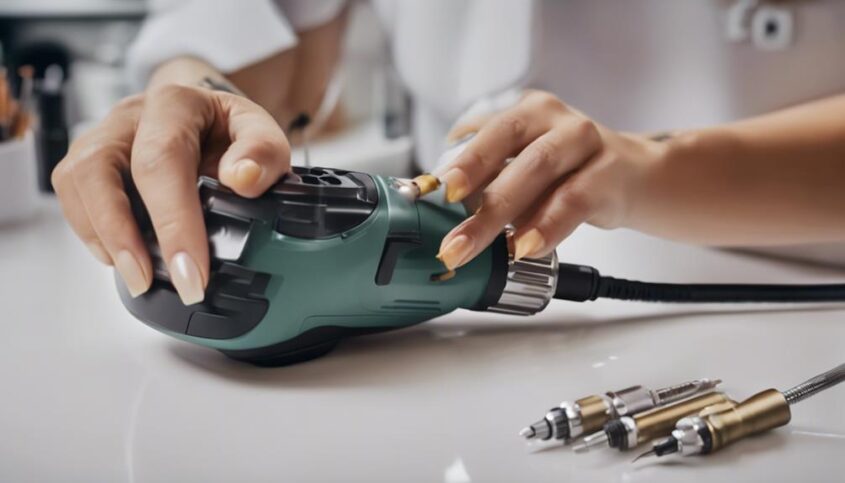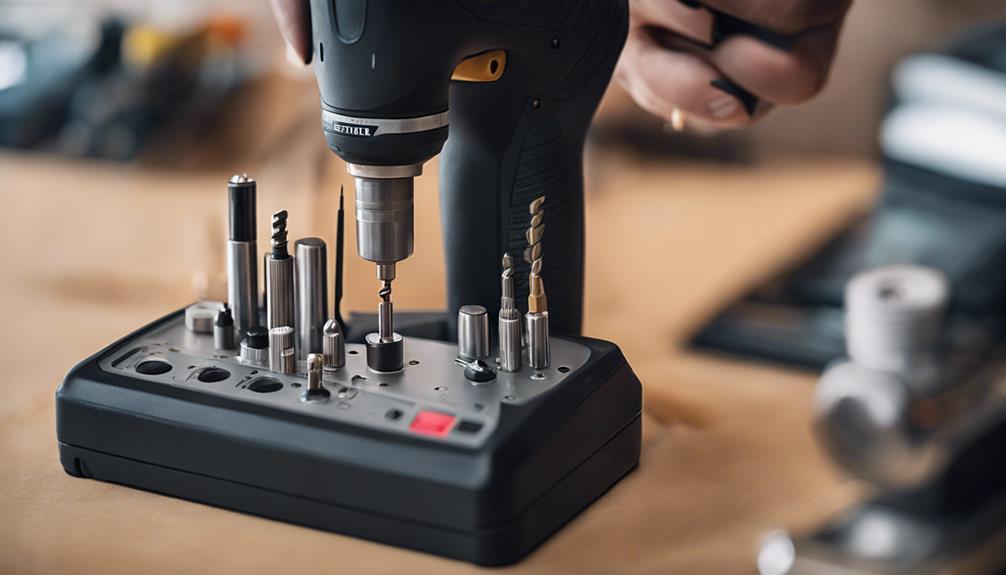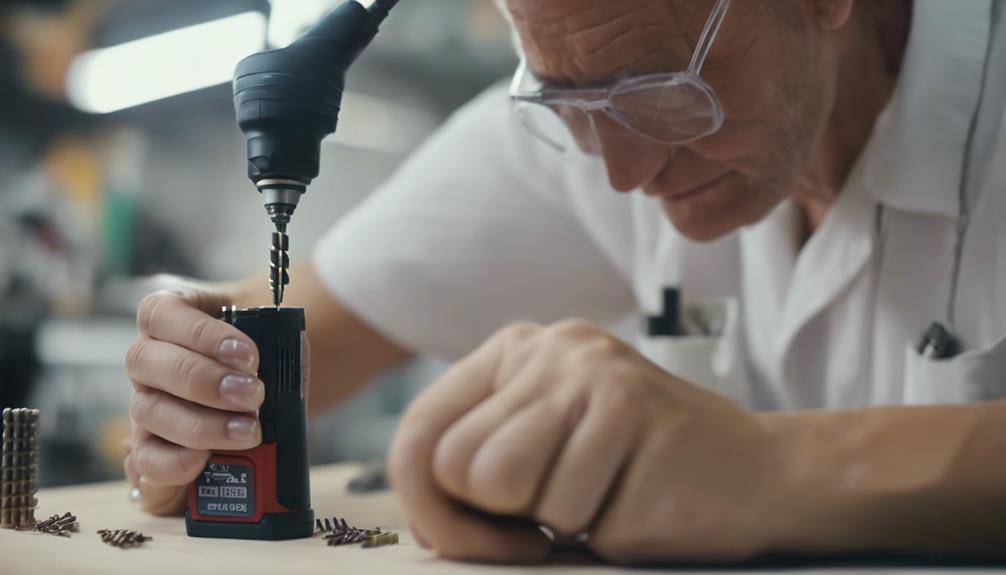What Kind of Drill Do Nail Techs Use?

Nail technicians commonly use electric nail drills for their power and adjustable settings, ideal for tasks like acrylic removal and gel filing. Electric drills offer consistent power and are versatile for various services. Factors to consider include high power, speed settings, portability, and interchangeable bits. Speed settings are crucial for precision work and safety. Drill bits, such as carbide and diamond, play a key role in nail techs' precision work. Furthermore, proper sanitation practices, like using disposable items and regular tool cleaning, are essential for maintaining a safe and hygienic working environment. Understanding these details helps nail techs provide top-notch services.
Key Takeaways
- Nail techs commonly use electric nail drills for efficiency.
- Manual drills are preferred for delicate nail art designs.
- High power, variable speed, and lightweight features are essential.
- Drill bits like carbide and diamond offer precision.
- Regular cleaning and disinfection prevent pathogen spread.
Types of Nail Drills

When exploring the world of nail drills, it is essential to understand the various types available to nail technicians. Nail drills play a crucial role in the efficiency and precision of nail services, making them a vital tool for professionals in the beauty industry. One of the most common types of nail drills is the electric nail drill, which offers high levels of power and speed, perfect for tasks such as filing, shaping, and buffing nails. These drills often come with adjustable settings to cater to different nail types and services. On the other hand, manual nail drills, which are operated by hand, provide a more traditional approach to nail care. They are often preferred for tasks that require a delicate touch or finer detail work. Additionally, manual drills offer portability and ease of use, making them a convenient option for on-the-go nail technicians. Understanding the differences between electric and manual nail drills can help professionals choose the right tool for their specific needs and preferences.
Electric Vs. Manual Drills
In comparing electric and manual drills for nail technicians, the choice between the two types hinges on factors such as power, precision, and convenience. Electric drills offer higher power levels, making them suitable for heavy-duty tasks and speeding up the nail enhancement process. They provide consistent RPM (revolutions per minute) for efficient filing and shaping. On the other hand, manual drills rely on the technician's hand movements for operation, offering precise control for intricate nail designs. Here is a comparison to help you decide:
- Power: Electric drills provide consistent power output, ideal for acrylic nail removal and thick gel filing.
- Precision: Manual drills offer precise control for delicate nail art and cuticle work.
- Convenience: Electric drills are more convenient for bulk services and quick nail enhancements.
- Versatility: Manual drills are versatile and suitable for detailed nail work and finishing touches.
Consider these factors to choose the drill type that best suits your nail technician needs.
Key Features to Consider

Essential considerations for nail technicians evaluating drills include key features that can significantly impact their nail enhancement procedures and overall efficiency. When selecting a drill, factors such as power, speed settings, portability, and versatility are crucial to enhance the nail technician's capabilities and streamline their workflow. Here are some key features to consider when choosing a drill:
| Feature | Description |
|---|---|
| Power | High power drills offer efficient and precise nail shaping and filing capabilities. |
| Speed Settings | Variable speed settings enable customization for different nail procedures and client needs. |
| Portability | Lightweight and cordless drills provide flexibility and ease of use in various settings. |
| Versatility | Interchangeable drill bits and accessories allow for a wide range of nail enhancement tasks. |
Importance of Speed Settings
An optimal selection of speed settings on a drill is fundamental for nail technicians seeking to tailor their nail procedures with precision and efficiency. The speed at which a drill operates can significantly impact the outcome of the nail service, making it crucial for professionals to understand and utilize the different speed settings available to them. Here are four key reasons why speed settings are important:
- Precision: Adjusting the speed settings allows nail technicians to work with finesse, enabling them to focus on intricate details and delicate nail art designs.
- Efficiency: Higher speed settings can expedite the nail service process, helping technicians save time without compromising on the quality of their work.
- Safety: Lower speed settings are essential for ensuring the safety of both the technician and the client, especially when working on sensitive areas or performing delicate procedures.
- Versatility: Different speed settings provide versatility, allowing nail technicians to adapt their techniques based on the client's needs and the type of nail service being provided.
Understanding Drill Bits

Understanding drill bits is a foundational aspect of mastering the tools and techniques necessary for precision and efficiency in nail services. Nail techs rely on drill bits to sculpt, shape, and refine nails with finesse. There is a plethora of drill bits available, each designed for specific purposes. For example, carbide bits are ideal for removing product quickly, while diamond bits excel in precision filing. Understanding the differences between these bits is crucial for achieving desired results and ensuring client satisfaction.
Innovations in drill bit technology have led to the development of specialized bits such as flame bits for cuticle work and safety bits to prevent accidental cuts. Tech-savvy nail technicians are constantly seeking new and improved drill bits to enhance their services and streamline their workflow. By staying informed about the latest advancements in drill bit design, nail techs can elevate their craft and deliver exceptional nail enhancements with ease.
Safety Tips for Nail Techs
Ensuring the safety of both nail technicians and clients is paramount in a salon environment. Protective gear, such as gloves and masks, should be worn at all times to prevent exposure to harmful chemicals. Proper ventilation is crucial to maintain air quality, and following a strict disinfection protocol is essential to prevent the spread of infections.
Protective Gear Importance
Proper utilization of protective gear is essential for nail technicians to ensure their safety and well-being while working. To enhance safety and minimize risks, nail techs should consider the following innovative protective measures:
- Nitrile Gloves: Provide a barrier against chemicals and prevent skin irritation.
- Safety Glasses: Shield the eyes from flying debris and chemical splashes.
- Nail Dust Mask: Filters out harmful particles and dust during filing.
- Apron or Lab Coat: Protects clothing from stains and chemical spills, ensuring a professional appearance.
Proper Ventilation Guidelines
Adequate ventilation is crucial for maintaining a safe and healthy work environment for nail technicians. Proper ventilation helps in reducing exposure to harmful chemicals present in nail products, ensuring the well-being of both the technicians and the clients. Here are some guidelines for maintaining proper ventilation in a nail salon:
| Ventilation Guidelines | Description |
|---|---|
| 1. Use Exhaust Fans | Install exhaust fans near workstations to remove fumes and odors. |
| 2. Open Windows | Allow fresh air to circulate by opening windows regularly. |
| 3. Air Purifiers | Consider using air purifiers to filter out airborne particles. |
| 4. Proper HVAC System | Ensure the heating, ventilation, and air conditioning system is well-maintained. |
| 5. Regular Inspections | Conduct regular inspections to check the effectiveness of ventilation systems. |
Disinfection Protocol Essentials
Implementing a thorough disinfection protocol is imperative for nail technicians to uphold high safety standards and protect the health of both staff and clients in the salon environment. To ensure a safe and hygienic workspace, nail techs should follow these essentials:
- Use Hospital-Grade Disinfectants: Opt for disinfectants that are effective against a broad spectrum of pathogens.
- Regularly Clean and Disinfect Tools: Scrub tools with soap and water, then disinfect them after each use.
- Sanitize Surfaces Frequently: Wipe down all workstations, chairs, and surfaces between clients.
- Implement Proper Hand Hygiene: Encourage handwashing and provide hand sanitizers for both staff and clients.
Frequently Asked Questions
Can Nail Drills Be Used to Remove Gel Polish?
Yes, nail drills can be used to remove gel polish. Careful use of a drill with the appropriate bit can effectively and efficiently remove gel polish without damaging the natural nail when done by a skilled professional.
Are There Any Specific Brands of Nail Drills That Are Recommended for Beginners?
For beginners, it is advisable to consider nail drill brands like MelodySusie, Makartt, and Beurer. These brands offer user-friendly features, adjustable speeds, and ergonomic designs, making them suitable choices for those starting their nail tech journey.
How Often Should Nail Drill Bits Be Replaced?
Regular maintenance and replacement of nail drill bits are crucial for optimal performance and client safety. It is recommended to replace bits every 3-6 months, or sooner if signs of wear or dullness are observed during usage.
Can Nail Drills Be Used on Natural Nails, or Are They Only for Artificial Nails?
Nail drills can be used on natural nails with care and proper technique. They are versatile tools that can aid in shaping, buffing, and maintaining the health of natural nails. It is crucial to use them skillfully to prevent damage.
Are There Any Special Techniques or Tips for Using a Nail Drill on Clients With Sensitive Skin or Nail Beds?
In the realm of nail care, addressing the unique needs of clients with sensitive skin or nail beds is crucial. Techniques such as using low speeds, gentle pressure, and specialized bits can enhance comfort and minimize potential irritation during nail drill procedures.




